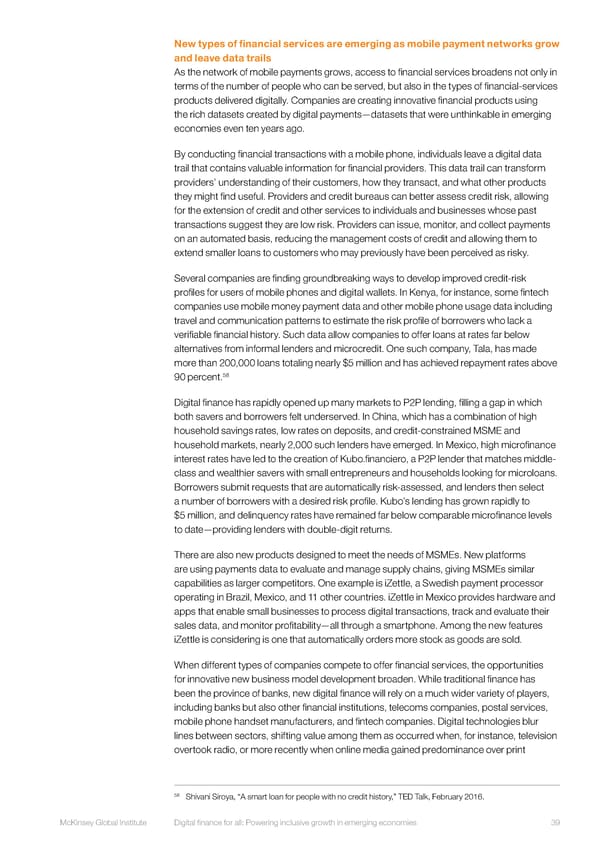New types of financial services are emerging as mobile payment networks grow and leave data trails As the network of mobile payments grows, access to financial services broadens not only in terms of the number of people who can be served, but also in the types of financial-services products delivered digitally. Companies are creating innovative financial products using the rich datasets created by digital payments—datasets that were unthinkable in emerging economies even ten years ago. By conducting financial transactions with a mobile phone, individuals leave a digital data trail that contains valuable information for financial providers. This data trail can transform providers’ understanding of their customers, how they transact, and what other products they might find useful. Providers and credit bureaus can better assess credit risk, allowing for the extension of credit and other services to individuals and businesses whose past transactions suggest they are low risk. Providers can issue, monitor, and collect payments on an automated basis, reducing the management costs of credit and allowing them to extend smaller loans to customers who may previously have been perceived as risky. Several companies are finding groundbreaking ways to develop improved credit-risk profiles for users of mobile phones and digital wallets. In Kenya, for instance, some fintech companies use mobile money payment data and other mobile phone usage data including travel and communication patterns to estimate the risk profile of borrowers who lack a verifiable financial history. Such data allow companies to offer loans at rates far below alternatives from informal lenders and microcredit. One such company, Tala, has made more than 200,000 loans totaling nearly $5 million and has achieved repayment rates above 58 90 percent. Digital finance has rapidly opened up many markets to P2P lending, filling a gap in which both savers and borrowers felt underserved. In China, which has a combination of high household savings rates, low rates on deposits, and credit-constrained MSME and household markets, nearly 2,000 such lenders have emerged. In Mexico, high microfinance interest rates have led to the creation of Kubo.financiero, a P2P lender that matches middle- class and wealthier savers with small entrepreneurs and households looking for microloans. Borrowers submit requests that are automatically risk-assessed, and lenders then select a number of borrowers with a desired risk profile. Kubo’s lending has grown rapidly to $5 million, and delinquency rates have remained far below comparable microfinance levels to date—providing lenders with double-digit returns. There are also new products designed to meet the needs of MSMEs. New platforms are using payments data to evaluate and manage supply chains, giving MSMEs similar capabilities as larger competitors. One example is iZettle, a Swedish payment processor operating in Brazil, Mexico, and 11 other countries. iZettle in Mexico provides hardware and apps that enable small businesses to process digital transactions, track and evaluate their sales data, and monitor profitability—all through a smartphone. Among the new features iZettle is considering is one that automatically orders more stock as goods are sold. When different types of companies compete to offer financial services, the opportunities for innovative new business model development broaden. While traditional finance has been the province of banks, new digital finance will rely on a much wider variety of players, including banks but also other financial institutions, telecoms companies, postal services, mobile phone handset manufacturers, and fintech companies. Digital technologies blur lines between sectors, shifting value among them as occurred when, for instance, television overtook radio, or more recently when online media gained predominance over print 58 Shivani Siroya, “A smart loan for people with no credit history,” TED Talk, February 2016. McKinsey Global Institute Digital finance for all: Powering inclusive growth in emerging economies 39
 DIGITAL FINANCE FOR ALL Page 51 Page 53
DIGITAL FINANCE FOR ALL Page 51 Page 53